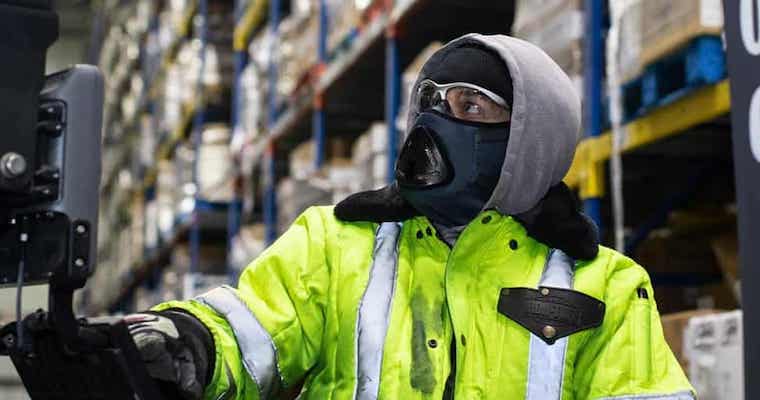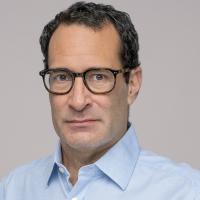Breathing easier with the Orindi Cold Endurance Mask

A cold storage industrial worker wearing The Orindi Cold Endurance Mask.
Editor's Note: This is the second in a series of articles featuring past winners of eFest, EIX's undergraduate business plan competition, and their journey since then.
Founded by Jordan Vanderham while a student at Grand Valley State University, Orindi manufactures a two-piece mask to make workers more comfortable in extremely cold environments, such as cold storage facilities and winter sports areas, in and outside Michigan. The Orindi Cold Endurance Mask features a balaclava to keep the head warm and a regulation unit to capture and feed heat and humidity so the wearer can breathe warmer, more comfortable air.
Now CEO, Jordan Vanderham has been an aspiring entrepreneur since the start of college. During the first two years, he taught middle school students at workshops about renewable energy. As asthmatic, Vanderham found teaching a class outdoors made him feel cold and gave him a runny nose.
As it so happened, the mechanical engineering major needed a business idea for an upcoming Startup Week at his school. He ended up pitching a set of nose plugs that prevented the inhalation of cold air, keeping the nose from becoming runny. More importantly however, that idea led to the birth of Orindi that same year, in 2016.
Vanderham described beginning a new product or startup company as a process including "phases of validation" and de-risking one's idea. Asking important questions along the way -- is this technology or service possible? Does it already exist? And are there existing markets that can be leveraged? -- helped Vanderham throughout his development process.
After making it to the final round of the 2017 student business contest e-Fest but coming away without a win, the company went on to win 3rd place in the 2018 competition after listening to customer feedback on how to improve the mask’s design.
“We went from a list of customer critiques and specifications, we developed something, and as soon as we could, we gave that mask to a snowboarder or cold storage worker,” Vanderham said. “They had it for maybe a day, and they would share us their critiques and we would circle back and continuously modify the product until it had minimal complaints about it."
The $20,000 e-Fest prize largely went towards production of an injection-molded part of the mask, allowing the company to print 960 of this part per day.
Orindi has around 125 masks of various iterations circulating for testing purposes, any of them between half a year to three-and-a-half years old. Vanderham manufactured the initial 50 completely in-house, “from the textile balaclava to the custom casted silicone facepiece.”
The company is partnered with a local injection company to produce the mask’s plastic components and works with a small, local sewing business run by Vanderham’s mother to produce the textile baclava.
Vanderham described Orindi as largely in the "pre-sale" phase. The mask still lacks some of the necessary parts. However, the company has given away several units to build up their sales channel, get customer feedback and ensure product/market fit.
Vanderham himself also tries to take shifts at companies piloting or buying his masks so that he too can gauge his product.
Most feedback for the masks however, has come from a mix of older, established cold storage industrial workers who prefer what they already have and younger workers who are more receptive to adopting the masks.
One anonymous testimonial from the House of Flavors ice-cream shop in Ludington, Michigan said: "This is a great product. I have made it mandatory in our flash freezers and it’s great for on boarding individuals who aren’t use to these extreme conditions in the freezer.”
Vanderham thinks the feedback is positive overall, and he believes they can help the majority of people who must work in extreme cold.
"It's never about money," Vanderham said, laughing. "If you want to go into entrepreneurship, money should be your last motivator. But I assume if you do good work with good people, the capital shouldn't be a problem."
While his product is tailored to industrial workers in cold storage facilities, he also wants his masks to go beyond this sector in the future.
"My next ambition will be to make smaller and more attractive masks for individuals and young kids with asthma, as that's the main driving force for me," Vanderham said. "It's silly to have your childhood stripped from being able to play outside because you can't breathe cold air."
"I am motivated by the 'why' of Orindi," he added, "which is empowering people to earn a livelihood or to just be themselves in cold environments, like the little individuals with asthma."
Here's a look at the company’s current status.
EIX STARTUP SNAPSHOT
|
The Product: |
The Orindi Cold Endurance Mask was designed to make breathing more comfortable in cold air in extreme environments like cold storage facilities. It captures and contains the warm exhaled air so that subsequent breaths take in this re-humidified air in place of the cold air outside the mask. |
|
Founding University |
Grand Valley State University (2016) |
|
The Potential Market: |
Cold storage industrial workers and others who work in environments of extreme cold, as well as people who suffer from cold-induced asthma. |
|
The Minimum Viable Product (MVP): |
Orindi developed a functioning prototype of its mask for the 2018 e-Fest competition, and has since improved upon that design. The company currently has a production product used by cold storage facilities across Michigan. |
|
Stage of Development: |
The company is currently building supply chain elements, focusing on preparing the masks for mass manufacturing and working on commercializing the masks for cold storage industrial workers. "Right now we're investing, so our financial goal is to have a runway of about one more year," Vanderham said. "Our financial goal is to invest into the product and we're confident that it will be sustainable into the future." For the winter, Vanderham also hopes to share their Orindi masks with a group of elementary school students prone to cold-induced asthma. |
|
Annual Sales: |
Orindi is still in the pre-sale phase: their mask doesn’t yet have all the capabilities and particular parts it requires. However, Orindi has given away a number of masks for COVID relief to people overwhelmed by the pandemic. The company printed some 300 masks to send to hospitals for use and evaluation. For Winter 2020, Vanderham also hopes to share their Orindi masks with a group of elementary school students prone to cold-induced asthma. "There's a lot more that happened," Vanderham said. "We worked on face shields with a bunch of other people as well… but it kept us productive, motivated and fulfilled while a lot of our primary customers, the cold storage workers, were trying to put out fires on their own side." |
|
Source of Idea: |
As a college student, Vanderham participated in an educational workshop on solar panels, in the cold, with his nose running. He also needed a business idea for a Startup Week, an event where entrepreneurs meet to form teams and then pitch ideas coordinated by those newly-formed teams. Vanderham’s team pitched a set of nose plugs preventing the intake of cold air; the concept in turn inspired the Orindi Mask. |
|
Traction: |
While they are not seeking investors at the moment, the company has talked with accelerators for business guidance. The prize money from the 2018 e-Fest also helped fund mass production of an injection-molded part of the mask, allowing the company to print more than 900 of this part per day. At this time, Orindi has around 125 of their masks, at various development stages, circulating for testing purposes at Michigan cold storage facilities, grocery stores, winter sports locations and similar cold environments. |
|
Biggest Challenge: |
Vanderham said that his biggest ongoing challenge since winning e-Fest has been transitioning from the company's primary engineer to a sales manager role. Vanderham also referenced the huge transition from college life to post-graduate life, where “the world assumes you into the position of getting a job, making money, paying off your debt, buying a house and buying a car.” |
|
How they’re dealing with the challenge: |
The CEO decided to focus simply on investing his time into his startup company, with the confidence that he'll get paid eventually and make that transition in full. Orindi is his primary obligation, but he has also taken up freelance engineering work to keep "irons in the fire for other product development opportunities." Vanderham is also working to surround himself with more sales-oriented persons and resources. The company will likely hire an internal sales partner or team up with a larger distributor this year as they continue to expand. |
|
Teammates: |
Industrial Design graduate Jared Seifert at the Kendall College of Art and Design. |
|
Mentors and Advisors: |
Advisor and former GVSU Collegiate Entrepreneurs Organization President Zoe Bruyn. GVSU Clinical Faculty member Tim Syfert also acted as Vanderham's primary advisor. |
|
Resources at college that helped: |
Vanderham said mentorship is a "fun way and productive way to learn." While in college, he consulted with three mentors every week or every other week. These mentors also help "hold you accountable for tasks," according to Vanderham. While not connected to Grand Valley State University itself, Vanderham also spent his time in college working with the SCORE Association for additional mentorship, the Entrepreneurial Support Organization (ESO) SURGE to ask legal and accounting questions, and Varnum Law (MiSpringboard) to obtain the patent and IP for the mask. |
|
Advice for aspiring Student Entrepreneurs: |
Vanderham advises reaching out to people to talk about your ideas, particularly professors of a similar mindset as your own. “An idea is just an idea,” Vanderham said. “The special part of an idea is the execution of it, and if you don't execute on a problem you want to solve, there's nothing to be had." "The worst you can do is fail,” he added. “I failed tons of times before I got to Orindi, and you just get better for the next time." He also recommends that students enter competitions as a means to gain momentum through effective mentorship, which he had with the 2017 and 2018 e-Fests. These opportunities vanish upon graduation, so it is best to take advantage of them before graduating. |


